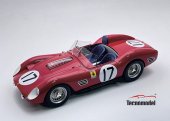ISSUE #21
COVER STORY
Lancia Rally 1982–1986
Interim solution – Conception and development of the Lancia Rally
Opportunity seized – The 1983 World Championship
Rearguard action – Until the arrival of the Delta S4
First love – Interview with designer Sergio Limone
INTERIM SOLUTION
Conception and development of the Lancia Rally
At the end of 1981 Lancia introduced the Rally, the first rally car fully designed around the new Group B ruleset. Simplicity in every detail, the use of existing parts and a short development phase were the goals which Sergio Limone, the project leader at Abarth, had set for himself. Conceived as an interim solution, the Lancia Rally used its window of opportunity and, in 1983, became the last rear-wheel-drive car to win the World Rally Championship.
It was a time when cars from the Fiat Group simultaneously dominated in Formula 1, the World Championship for Makes and the World Rally Championship. In 1975 to 1977 and 1979 Ferrari won four constructors’ titles in F1, Lancia won the sports car world title with the Group 5 Montecarlo Turbo in 1980 and 1981, and in rallying success had started with Lancia in 1974 with three consecutive World Championships with the Stratos, before another three titles in 1977, 1978 and 1980 with the Fiat 131 Abarth.
Around this time there were developments emerging on the rallying scene that would drastically change the sport. Until the early 1970s rally cars were still very similar to their road-going counterparts. They were powered by tuned production engines, through the rear wheels only. The drivers used their right foot to steer the car more than the actual steering wheel. Corners were typically attacked at a high drift angle.
The Stratos, launched at the Turin Salon in November 1971, was the first purpose-built rally car. The road-going version was built purely to meet homologation targets. From ’74 onwards the car showed what was possible with a proper rally car. But still, there was never a successor to the Stratos. When its time was over, tuned versions of mass-produced road cars like the Ford Escort and the 131 Abarth took control again…
by Harold Schwarz
Photographs: Sammlung Sergio Limone, McKlein
FIRST LOVE
Interview with designer Sergio Limone
Sergio Limone, born in 1948 in Turin, has shaped the sporting history of Fiat, Lancia, and Alfa Romeo. After graduating university and joining the development department at Abarth, he quickly rose to the position of chief engineer and was tasked with overseeing numerous projects – including the Alfa 155 V6 Ti, which we covered in detail in AUTOMOBILSPORT #16. For our latest Issue, Limone has granted us an exclusive interview to talk about his first masterpiece: the Lancia Rally.
AUTOMOBILSPORT: Looking back, what does the Lancia Rally mean to you personally?
Limone: In Italy we say ‘you never forget your first love’, and that is the case with the SE037 project for me as an engineer. It was my first big project. I had only a little bit of experience from the development of the Fiat 131 Abarth, because I was the junior assistant to Mario Colucci, the great father of all Abarth cars from the 1960s to the 1980s, so I had big shoes to fill. Colucci had resigned because of a dispute with Aurelio Lampredi, the President of Abarth Corse, so I was in charge of the new Group B project. I was only 32 years old, and I was in charge of the design of the whole car, except for the engine.
AUTOMOBILSPORT: What was the most difficult part in the development of the Lancia Rally, and where did you get your ideas from?
Limone: The most difficult parts where the cylinder head casting – we had a lot of trouble with it at the beginning – and the rear subframe. The latter was too fragile for gravel rallies like Acropolis. We solved that problem with some additional gussets. The main idea was to produce a simple design, based on Abarth experience, using existing parts and technologies – for example, the main body from the Montecarlo, the ZF gearbox from DeTomaso, and welded subframes on a steel body.
AUTOMOBILSPORT: What was special about developing a rally car, compared to a racing car like the Alfa 155 V6 Ti? …
by Harold Schwarz
Photographs: Sammlung Sergio Limone, McKlein
Interview with René Arnoux
During his long, impressive Formula 1 career, René Arnoux drove for three major teams: Renault, Ferrari and Ligier. With seven wins and 18 pole positions, he remains to this day the second-most successful French F1 driver behind Alain Prost. Exactly 30 years ago he contested his final season of Grand Prix racing – a good occasion for AUTOMOBILSPORT to review the career of this colourful character. Etienne Bourguignon interviewed the now 70-year-old champion at his home in Lausanne.
AUTOMOBILSPORT: You started your career in karting at the age of 12. In 1972, aged 24, you won the ‘Volant Shell’ on the Magny-Cours racetrack. A success that earned you a seat in Formula Renault backed by Shell in 1973. At the end of your first-ever single-seater racing season, you achieved something that no one had done before: you won the title outright, beating the likes of Didier Pironi and Patrick Tambay, winning seven out of 20 races. For the following season, Shell unexpectedly pulled out of its sponsorship and 1974 became effectively a lost year for you.
Arnoux: Yes, what a waste! I had just won the Formula Renault Eurocup in my first attempt. Shell had warned me that offers would come from other teams. They told me that they wanted me to stay with them and drive a Surtees Formula 2 car which they sponsored. Since Shell had backed me from the start, I stayed with them. John Surtees too wanted me in his team, which was great. Unfortunately, as time went on Surtees never received any money from Shell. I’d already moved to England and was working as a mechanic with Team Surtees whilst waiting to get back behind the wheel. Out of nowhere, Shell suddenly pulled out, and my F2 season was over before it had even started. I was left without a drive in ’74 and was utterly disappointed.
AUTOMOBILSPORT: In 1975 Elf came to the rescue, backing you for another season in Formula Renault. You repaid them with a second title in a Martini Mk15.
Arnoux: That year, from the moment I got the help of Elf thanks to the support of their marketing boss François Guiter, I won a lot of races and won the title. When the championship was over, Mr Guiter told me: ‘René, watch out, you will receive offers from other people. I suggest we do the F2 championship together.’ I answered: ‘Mr Guiter, it’s up to you! You decide, and I’ll drive.’ Finally, we shook hands, didn’t sign anything and went into Formula 2 together without a contract.
AUTOMOBILSPORT: You went into Formula 2 with constructor Tico Martini, whom you had worked with before. Your teammate was Patrick Tambay, and you also had your first encounter with a certain Jean-Pierre Jabouille in F2. After a very close season, the title was decided at the last race in Hockenheim.
by Etienne Bourguignon
Photographs: The Cahier Archive, Sammlung Etienne Bourguignon, McKlein, Klemantaski, Sammlung Nils Ruwisch, Motorsportimages, Kräling
Championship Alliance
Jackie Stewart and Matra
On 11 June the oldest living Formula 1 World Champion turned 80 years old. Five decades ago he won the first of his three titles. To this day it’s the only championship won in a car built in France, and a car entered by a privateer team.
My interest in motorsport and Formula 1 was sparked during the Jackie Stewart era. In my mind, an ‘era’ for a driver is the time when he is the man to beat in a Grand Prix and in the World Championship.
Before the Jackie Stewart era, there was the Jim Clark era. Between 1962 and 1968 the older of the two Scots was undisputedly F1’s top driver. Clark only won two titles and a total of 25 races, thanks to both the famous Lotus fragility and the lack of a competitive engine in the early days of the three-litre regulations in 1966 and 1967. The Jim Clark era ended abruptly when Clark was killed in April 1968. The Formula 1 world wondered who would succeed him, who was to lead the next era.
As it turned out, Clark’s successor was a fellow Scot. John Young Stewart, known as Jackie, born in Milton, Dumbarton – about 20 kilometres north-west of Glasgow – on 11 June 1939. His father ran a garage situated on the A82 between Glasgow and Inverness. Jackie had a brother eight years his senior, Jimmy, who was a racer himself in the early 1950s. He ended his career aged 24 after a number of crashes.
Jackie found school very difficult. It was only at 41 years of age, when his son showed similar signs, that he was diagnosed with dyslexia. After school, which Jackie left as early as possible, he completed an apprenticeship and worked in his father’s workshop. There he came into contact with customers who competed in club racing. At some point someone offered Jackie a go behind the wheel. He was fast, and the word spread…
by Harold Schwarz
Photographs: Cahier, Motorsportimages, McKlein, Kräling
ALSO IN THIS ISSUE
- Rainer Braun on Dieter Quester
- Eckhard Schimpf on Ferdinand Piëch and the Porsche 917
- Back on Track BMW 635 CSi Gr.2
- Moritz Werner on recent auctions and sales
- and many more!















This product was added to our catalog on Friday 23 August, 2019.




